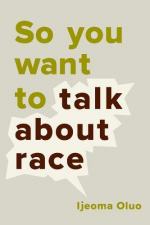
|
| Name: _________________________ | Period: ___________________ |
This test consists of 5 multiple choice questions, 5 short answer questions, and 10 short essay questions.
Multiple Choice Questions
1. What is NOT a term deemed by Oluo to be a problematic piece of language in regards to race?
(a) Articulate.
(b) Uppity.
(c) Thug.
(d) Hip-hop.
2. The implementation of what policy in schools is said to be one of the main contributors to the school-to-prison pipeline?
(a) Dress code.
(b) Attendance.
(c) In-school suspension.
(d) Zero-tolerance.
3. Which ethnicity does Oluo NOT name as one wrapped up in the stereotype of the studious, hardworking Asian?
(a) Chinese.
(b) Vietnamese.
(c) Korean.
(d) Japanese.
4. What habit did Oluo develop as a result of white people telling her that her hair is "poufy" (128)?
(a) She twirled her hair.
(b) She pulled her hair out.
(c) She wore hats.
(d) She constantly patted her head.
5. Oluo states that at the time of the incident with the division director, she was working in what city?
(a) Houston.
(b) Seattle.
(c) Philadelphia.
(d) Chicago.
Short Answer Questions
1. The division director made the situation worse by asking Oluo if she had seen a documentary narrated by which comedian?
2. What superlative does Oluo use to describe the way in which cultural appropriation functions as a topic of discussion?
3. Which comedian and actor was known as America's dad due to his role as Cliff Huxtable on television?
4. Oluo recalls being told by white classmates that at least black men liked what quality she possessed?
5. Oluo states that which common elements of public education are tailored to white students?
Short Essay Questions
1. What historical context does Oluo consider crucial to any conversation about white people's desires to touch black people's hair?
2. What is Oluo’s advice regarding white people’s use of the ‘n’ word and how does her advice value compassion over understanding?
3. What is the real problem with the model minority myth, according to Oluo?
4. Who was Tamir Rice and why is his story significant?
5. In what ways was Oluo led to believe that there were things wrong with her identity when she was growing up?
6. What was the number one quality in a friend that meant the most to Oluo during her childhood and why?
7. What length of time does Oluo claim will have to pass before white people can utter the ‘n’ word without causing harm to black people?
8. What is the goal of affirmative action?
9. What does the ramen symbolize within Oluo’s anecdote about a sleepover in Chapter 7: How Can I Talk About Affirmative Action?
10. In what year of high school did Oluo attend a conference for promising students of color and how does she characterize the experience?
|
This section contains 1,163 words (approx. 4 pages at 300 words per page) |

|




